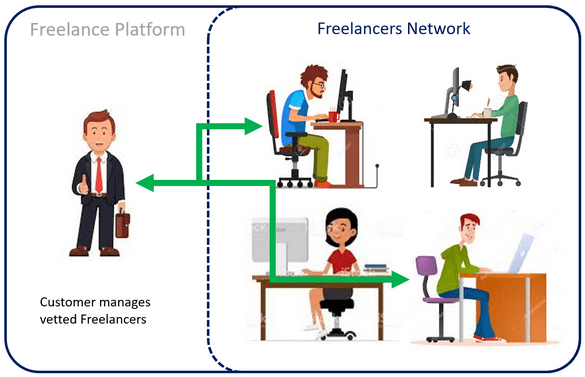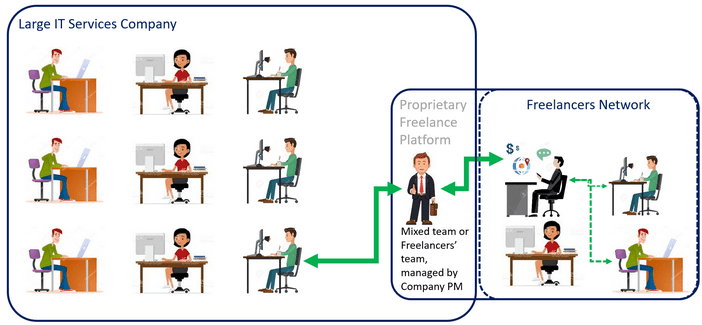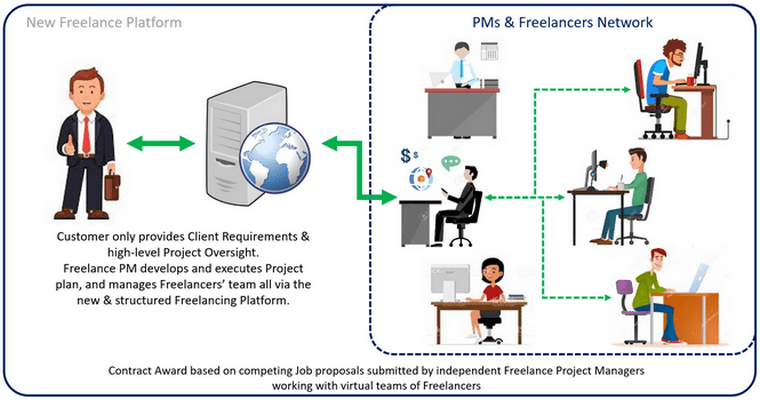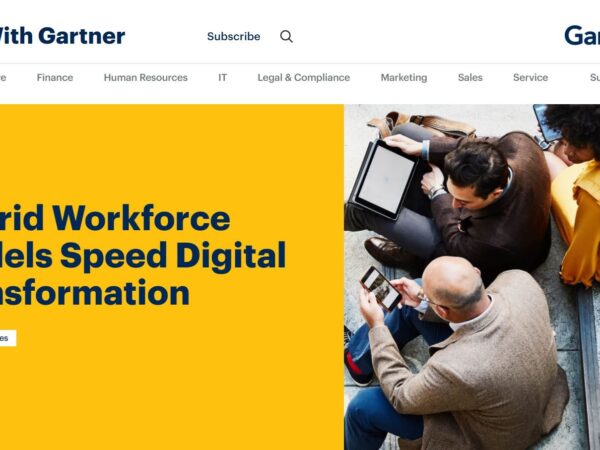In this article, we compare the typical online Freelancing models in use today as well as their value propositions, explore usage context & key shortcomings, and lead into an evolutionary Freelancing model that can help all Users derive greater value from Freelancing, at lowered risk levels.
Background
The Online Freelancing platforms that exist today can be categorized based on the following factors:
- Number of stakeholders on either side of the engagement: Service Buyer & Service Provider.
- Who manages the Freelance engagement (Including: Freelancer search/ identification/ engagement; Work planning; Work allocation, execution, monitoring, integration, & delivery; Invoicing & Payments; Freelancer Performance assessment & feedback; etc) — Is this the Service Buyer, the Service Provider, or Platform-supplied resources?
- Is the Platform is an open Marketplace with competing Service providers, or does the Platform offer a “Managed Service” operating model, with resources being allocated by the Platform for a given job after contract signing?
- Is the platform supporting a specific Company’s needs, opposed to an open Marketplace where any Customer can provided service, and any Freelancer can provide service (subject to documented rules & constraints) ?
Based on the above considerations, there may be other implications on the capabilities of the Freelancing models, such as:
- Platform-supported size & complexity of work to be freelanced,
- Risk level for Customers, resulting from levels of control enabled (of Freelancers & their bandwidth allocation to the work in question), transparency enabled (into the status of work execution, challenges to progress, timeliness of work execution, quality of job outputs), etc.
Existing Freelancing platform types
Based on the above qualifiers, the following categories of Freelancing models can be identified.
Peer-to-Peer Freelancing model

This is the simplest Online Freelancing model, where:
- A Customer publishes a Job on the platform.
- The Customer invites specific Freelancers to the Job, and/or publish the Job in the public domain.
- Freelancers submit competing Proposals to the Customer.
- The Customer reviews the proposals received, review the Performance ratings & Portfolios of competitor Freelancers, and identify the winning Freelancer.
- The Customer signs contract with the winning Freelancer, for an agreed amount, with the contract including terms relating to completion criteria, milestones, milestone completion criteria, and payment schedule.
- The Freelancer performs work, and submits each Milestone deliverable (or Contract deliverable) to the Customer.
- The Customer reviews the deliverables, accepts it/ returns for further work, and after accepting, makes the milestone/ contract payment.
- The Customer submits a simple Performance assessment & feedback to the Freelancer at the end of the Job.
The key differentiators/ USP of this model are:
- Simple operational model; and
- Simple collaboration model.
This model is best suited for Small-to-medium sized jobs, where the Customer has the capability to assess and manage the Freelancer, the work performed, & the quality/ adequacy of outputs or services delivered.
Freelancer Staff Augmentation model

This is another simple Online Freelancing model, where:
- The platform team takes each Freelancer through a very detailed testing & interview process, assesses the skill levels of each Freelancer who applies to the platform, and sets an hourly chargeable rate for the Freelancer on the platform.
- The Customer submits a job to the platform, and searches the platform for Freelancers with specific skillsets and experience levels.
- After identifying the Freelancers he/ she requires, the Customer approaches the platform to engage the specified Freelancers, at the Hourly rates that are already published on the platform.
- The Customer assigns work tasks to the Freelancers thus engaged, and they perform work as assigned.
- If the Freelancers turn out to be less skilled than committed, and are unable to complete the assigned work, the platform replaces the Freelancers for free.
- The Customer makes payment to the platform, and the platform in turn pays the Freelancers after taking out platform commissions.
- The Customer submits a simple Performance assessment & feedback to the Freelancers at the end of the Job.
The key differentiators/ USP of this model are:
- Simple operational model;
- Vetted Freelancers (top x% of the population) who are replaced at the platform’s cost if found unsatisfactory; and
- Simple collaboration model.
The key shortcomings of this model are:
- If the Customer does not have the requisite skills to manage the hired Freelancers and integrate their work outputs (or guide the team as they perform the integration), the job may not result in a successful outcome for the customer, specially in a “large project” context.
This model is best suited for Medium-to-Large jobs which require resources with strong skills, and where the Customer has the capability to assess and manage: the Freelancers, the work being performed, and the quality/ adequacy of outputs/ services delivered.
Managed Service Delivery Freelancing model

This is a more complex Freelancing model, where:
- The platform team assesses the skill levels of each Project Manager who applies to the platform, using very detailed testing & interview process, and admits the Project Manager to the platform only after passing the rigorous testing & interviews.
- When a Customer publishes a job on the platform, the platform searches through its registry and identifies the most suitable project manager for the job, given the constraints of domain, industry, skills, etc, and then assigns the Job to the Project Manager identified.
- The Project Manager analyzes the job, identifies skills needed, resource mix needed, etc, and then searches through the platform’s registry to identify suitable freelancers for the job based on skills match & bandwidth availability.
- The Project Manager breaks up the job into appropriate components, assigns the job to the selected freelancers, and then asks them to analyze the job & develop their component proposals & effort/ schedule/ cost estimates.
- The Project manager works with the Freelancer team to develop appropriate Milestone Delivery & Payment schedules, generate a unified Proposal, and submits it to the Customer via the platform.
- The Customer reviews the proposal, and if he/she finds it acceptable, signs the contract. If the Customer does not find the Proposal acceptable due to whatever reason, the contract is abandoned, and the Customer is free to look elsewhere to execute the Job.
- After contract signing, the Project Manager leads the execution of the Job, submits deliverables to the Customer in line with the Milestone schedule, and receives payments.
- The Customer submits a simple Performance assessment & feedback to the Project Manager at the end of the Job.
- The Project Manager submits a simple Performance assessment & feedback to the Freelancers at the end of the Job.
The key differentiators/ USP of this model are:
- Vetted PMs backed by Platform commitments of skills & availability
- Simple Service delivery model that suits Hands-off Customers.
The key shortcomings of this model are:
- No competition during Job solutioning — The Customer only has the option to accept the assigned Project Manager as well as the Proposal built, or to reject it. This lack of competition could drive up costs for the Customer.
- Lack of built-in tools to enable “best team for the job”.
- Lack of built-in tools to support Project planning & management.
- Lack of built-in tools to boost teaming and trust across a distributed team.
This model is best suited for Medium-to-large sized jobs where the Customer does not have the capability or intent to closely perform Resource management & Project Delivery management functions.
Proprietary Staff Augmentation model

This is a very specific scenario of the “Freelancer Staff Augmentation model” described earlier.
Here, the Service Customer is a large IT Services company, looking to augment its’ existing team using Freelancers on specific jobs, and is hosting a Freelancing platform for this specific purpose. The Resource Management & Project Management functions shall also be performed by Project Manager(s) from the hosting Company. There may be two types of teams formed, using this model:
- A “Mixed team” comprising of Freelancers on the platform, as well as employees of the IT Services company, OR
- A “Freelance team” comprising only of Freelancers on the platform.
Freelancers joining this platform shall be taken through a thorough vetting process before being admitted to the platform.
Major functionalities needed for a Freelancing makeover
Needs from Businesses
In order to really improve confidence of Businesses to engage Freelancing platforms, and to expand the scope of their freelanceable work, the following needs would to be systemically addressed:
- Drive up productivity by improving team engagement,
- Improve Businesses’ on-demand visibility of work status & roadblocks in work execution, while enabling full-team alignment on current status vs plan,
- Enable improved controls through improved planning mechanisms,
- Enable execution of projects as well as programs/ initiatives via Freelancing, and
- Enable cost takeouts for Businesses.
Needs from Freelancers
In order to drive up freelancers’ acceptance of the Freelancing platform, and to significantly enhance the Freelancers’ pool available, the following needs would to be systemically addressed:
- Contain payment disputes,
- Enhance the scope of freelanceable work in organizations,
- Enable improved team engagement, and
- Enable Freelancers to grow in their career, and get the opportunity to work on more complex work that is aligned to their skill levels and aspirations.
Needs from Consulting Agencies
In order to drive up Consulting Agencies’ acceptance of the Freelancing platform, the following needs would to be systemically addressed:
- Enable improved team engagement,
- Enable seamless scaling of teams, and
- Enable improved Portfolio management to better support “preferred” Customers.
Proposed Freelancing model
After analyzing the value propositions & shortcomings of existing Freelancing models, the following recommendations have been developed, to enable in-control & cost-effective execution of large projects:
- The new Freelancing platform should enable competition amongst Freelance Project Managers, to drive cost takeouts for Customers.
- The new Freelancing platform should integrate functions & processes from Freelancing, Project Management, Portfolio Management, Crowdsourcing, and Collaboration, in order to enable structure, control, transparency, & scalability.

The next post in this series is coming soon: How Outsourcing is evolving, and how Customers and Service Providers can gain advantage in the marketplace.
By the way, you may also like to read the previous articles in this series. The last one was titled: A comparison of Staff Engagement Models in Organizations.



